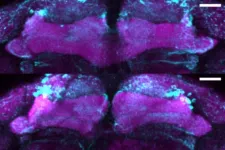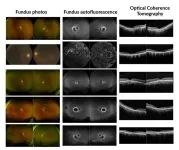(Press-News.org) A groundbreaking new study conducted by a team of researchers from Arizona State University, University of Washington and the University of Texas at Austin reveals that extreme heat significantly alters how people go about their daily lives, influencing everything from time spent at home to transportation choices. The study, titled "Understanding How Extreme Heat Impacts Human Activity-Mobility and Time Use Patterns," was recently published in Transportation Research Part D and underscores the urgent need for policy action as cities around the world grapple with rising temperatures.
The research was led by Ram M. Pendyala, a professor at ASU's School of Sustainable Engineering and the Built Environment, along with co-authors Irfan Batur, Victor O. Alhassan, Mikhail V. Chester and Steven E. Polzin from Arizona State University; Cynthia Chen from the University of Washington; and Chandra R. Bhat from the University of Texas at Austin. The study provides detailed insights into how extreme heat affects daily activity-travel behavior and time use patterns for different socio-demographic groups. It draws on data from the American Time Use Survey (ATUS) and weather data from the National Oceanic and Atmospheric Administration (NOAA), focusing on 11 major U.S. metropolitan areas: Atlanta, Chicago, Dallas, Houston, Los Angeles, Miami, New York, Philadelphia, Phoenix, Seattle and Washington, D.C.
The collaborative effort emphasizes the importance of understanding the effects of extreme heat on everyday activities and mobility choices to inform policy solutions that can address growing climate challenges and has been enabled through two major sponsored research initiatives, including a National Science Foundation (NSF) LEAP-HI (Leading Engineering for America’s Prosperity, Health, and Infrastructure) project led by the University of Washington and two U.S. Department of Transportation UTCs (University Transportation Centers), namely the TOMNET center led by ASU and the National Travel Behavior and Demand (TBD) center led by the University of Texas at Austin.
Heat Alters Daily Routines
According to the study, extreme heat significantly reduces the amount of time people spend outside their homes. On extremely hot days, people are more likely to stay indoors, cut back on outdoor activities and avoid non-essential travel. For instance, the data shows a marked decrease in trips made for leisure, shopping and socializing when temperatures soar. Additionally, people shift their travel to cooler times of the day, opting for early morning or late evening trips to avoid midday heat.
The research shows a clear shift in transportation choices under extreme heat conditions. Car use increases, while trips made by walking, biking and public transit drop significantly. On average, public transit trips fall by nearly 50% on extreme heat days, as individuals seek relief in air-conditioned private vehicles. The authors note that this shift presents significant challenges for cities aiming to promote sustainable transportation options like walking and public transit, especially as communities experience climate extremes with greater frequency.
Vulnerable Groups Face the Biggest Challenges
The study also found that some groups are particularly vulnerable to the adverse effects of extreme heat. Low-income individuals and those without access to cars are more likely to rely on walking or public transportation, modes that leave them exposed to dangerous temperatures. These individuals are also those with the least flexibility in terms of when and where they work, thus necessitating travel even when temperatures are oppressive.
While higher income individuals reported making significantly less trips on extremely hot days, lower income individuals and those without access to a car did not show appreciable drops in daily trip-making, suggesting that they are more vulnerable and exposed to the deleterious effects of extreme heat. The research also highlights that older adults experience greater challenges in adapting their daily routines and risk experiencing social isolation on days that they shelter indoors from the heat.
“We see that extreme heat exacerbates inequities in mobility and activity-travel participation,” said Pendyala. “Those who are already at a disadvantage, such as low-income individuals or those dependent on public transportation, face even greater risks during heat waves. This is a clear call for targeted policy interventions to protect the most vulnerable population groups.”
Policy Recommendations to Tackle the Heat
Considering these findings, the authors propose a range of policy recommendations to help mitigate the impacts of extreme heat on communities. These include creating shaded public spaces, offering vouchers for on-demand door-to-door transportation for vulnerable populations and declaring "heat days" when people are encouraged to stay indoors, excused from traveling to the workplace, and able to access cooling centers if their homes are not adequately temperature controlled. In other words, the study calls for declaring “extreme heat” days that are similar to “snow” days when workplaces, businesses and schools are often closed to protect the public. Urban design improvements such as planting more trees and using heat-reflective materials on pavements can also help make cities more resilient to rising temperatures.
"Addressing the challenges associated with extreme heat is not just a matter of urban design, but of equity and public health and wellbeing," said lead co-author Irfan Batur. "We need to take decisive action to ensure that our cities are equipped to protect all residents from the dangers of extreme heat."
A Warming Future Requires Adaptation
With extreme heat events becoming more frequent and severe due to climate change, the study’s findings are especially timely. The research highlights the critical need for cities to incorporate heat mitigation strategies into their transportation and urban planning efforts.
The team hopes that their findings will prompt policymakers to take immediate steps to create more heat-resilient cities.
“This research sheds light on how heat can disrupt daily life and travel in ways that are potentially harmful for the most vulnerable population groups,” Pendyala noted. “Our goal is to provide the evidence necessary to drive meaningful change.”
END
Extreme heat impacts daily routines and travel patterns, study finds
New research highlights inequities in heat adaptation calling for policy changes to address growing heat challenges
2024-09-26
ELSE PRESS RELEASES FROM THIS DATE:
ReadCube expands literature management with new AI Assistant and comprehensive search
2024-09-26
Digital Science announces ReadCube Pro, an AI-powered expansion of ReadCube, offering researchers new tools to simplify and accelerate literature management and literature monitoring workflows.
The new AI Assistant and Literature Monitoring in ReadCube – an award-winning leader in literature management and full-text document delivery – transform the way research teams access, organize, review and monitor scholarly literature by providing them with enhanced search capabilities while helping to significantly reduce time spent ...
New mutation linked to early-onset Parkinsonism
2024-09-26
Leuven, 26 September 2024 – A team of scientists led by Prof. Patrik Verstreken (VIB-KU Leuven) has identified a new genetic mutation that may cause a form of early-onset Parkinsonism. The mutation, located in a gene called SGIP1, was discovered in an Arab family with a history of Parkinson's symptoms that began at a young age. The study reveals that this mutation affects how brain cells communicate, providing new insights into the disease's development and potential treatment strategies.
A genetic clue to Parkinsonism
Parkinsonism is a group of neurological disorders that share similar symptoms, including motor dysfunction ...
Bacteria involved in gum disease linked to increased risk of head and neck cancer
2024-09-26
More than a dozen bacterial species among the hundreds that live in people’s mouths have been linked to a collective 50% increased chance of developing head and neck squamous cell carcinoma (HNSCC), a new study shows. Some of these microbes had previously been shown to contribute to periodontal disease, serious gum infections that can eat away at the jawbone and the soft tissues that surround teeth.
Experts have long observed that those with poor oral health are statistically more vulnerable than those with healthier ...
These fish use legs to taste the seafloor
2024-09-26
Sea robins are unusual animals with the body of a fish, wings of a bird, and walking legs of a crab. Now, researchers show that the legs of the sea robin aren’t just used for walking. In fact, they are bona fide sensory organs used to find buried prey while digging. This work appears in two studies published in the Cell Press journal Current Biology on September 26.
“This is a fish that grew legs using the same genes that contribute to the development of our limbs and then repurposed these legs to find ...
This fish has legs
2024-09-26
Sea robins are ocean fish particularly suited to their bottom-dwelling lifestyle: Six leg-like appendages make them so adept at scurrying, digging, and finding prey that other fish tend to hang out with them and pilfer their spoils.
A chance encounter in 2019 with these strange, legged fish at Cape Cod’s Marine Biological Laboratory was enough to inspire Corey Allard to want to study them.
“We saw they had some sea robins in a tank, and they showed them to us, because they know we like weird animals,” said Allard, a ...
Climate change: Heat, drought, and fire risk increasing in South America
2024-09-26
The number of days per year that are simultaneously extremely hot, dry, and have a high fire risk have as much as tripled since 1970 in some parts of South America. The results are published in a study in Communications Earth & Environment.
South America is warming at a similar rate to the global average. However, some regions of the subcontinent are more at risk of the co-occurrence of multiple climate extremes. These compound extremes can have amplified impacts on ecosystems, economy, and human health.
Raúl Cordero and colleagues calculated the number of days per year that each approximately 30 by 30 km grid ...
Rates of sudden unexpected infant death before and during the pandemic
2024-09-26
About The Study: This cross-sectional study found increased rates of both sudden unexpected infant death (SUID) and sudden infant death syndrome (SIDS) during the COVID-19 pandemic, with a significant shift in epidemiology from the pre-pandemic period noted in June to December 2021. These findings support the hypothesis that off-season resurgences in endemic infectious pathogens may be associated with SUID rates, with respiratory syncytial virus (RSV) rates in the U.S. closely approximating this shift. Further investigation into the role ...
Estimation of tax benefit of nonprofit hospitals
2024-09-26
About The Study: This study highlights the wide variation of nonprofit hospitals’ tax benefit across states, its high concentration among a small number of hospitals, and the primary role played by state and local taxes. Policy efforts to strengthen nonprofit hospitals’ taxpayer accountability are likely to be more effective when pursued at the local level.
Corresponding Author: To contact the corresponding author, Ge Bai, PhD, CPA, email gbai@jhu.edu.
To access the embargoed study: Visit our For The Media ...
Scientists discover gene responsible for rare, inherited eye disease
2024-09-26
Scientists at the National Institutes of Health (NIH) and their colleagues have identified a gene responsible for some inherited retinal diseases (IRDs), which are a group of disorders that damage the eye’s light-sensing retina and threatens vision. Though IRDs affect more than 2 million people worldwide, each individual disease is rare, complicating efforts to identify enough people to study and conduct clinical trials to develop treatment. The study’s findings published today in JAMA Ophthalmology.
In a small study of six unrelated participants, researchers linked the gene UBAP1L to different forms of ...
Scientists discover "pause button" in human development
2024-09-26
In some mammals, the timing of the normally continuous embryonic development can be altered to improve the chances of survival for both the embryo and the mother. This mechanism to temporarily slow development, called embryonic diapause, often happens at the blastocyst stage, just before the embryo implants in the uterus. During diapause, the embryo remains free-floating and pregnancy is extended. This dormant state can be maintained for weeks or months before development is resumed, when conditions are favorable. Although not all mammals use this reproductive ...
LAST 30 PRESS RELEASES:
Orthopedics can play critical role in identifying intimate partner violence
Worms as particle sweepers
Second spider-parasitic mite described in Brazil
January 2026 issues of APA journals feature new research on autism, pediatric anxiety, psychedelic therapy, suicide prevention and more
Private equity acquired more than 500 autism centers over the past decade, new study shows
New cervical cancer screening guidelines from the US Department of Health and Human Services
Estimated burden of COVID-19 illnesses, medical visits, hospitalizations, and deaths in the US from October 2022 to September 2024
Smartphone use during school hours by US youth
Food insecurity and adverse social conditions tied to increased risk of long COVID in children
Earliest, hottest galaxy cluster gas on record could change our cosmological models
Greenland’s Prudhoe Dome ice cap was completely gone only 7,000 years ago, first GreenDrill study finds
Scientific validity of blue zones longevity research confirmed
Injectable breast ‘implant’ offers alternative to traditional surgeries
Neuroscientists devise formulas to measure multilingualism
New prostate cancer trial seeks to reduce toxicity without sacrificing efficacy
Geometry shapes life
A CRISPR screen reveals many previously unrecognized genes required for brain development and a new neurodevelopmental disorder
Hot flush treatment has anti-breast cancer activity, study finds
Securing AI systems against growing cybersecurity threats
Longest observation of an active solar region
Why nail-biting, procrastination and other self-sabotaging behaviors are rooted in survival instincts
Regional variations in mechanical properties of porcine leptomeninges
Artificial empathy in therapy and healthcare: advancements in interpersonal interaction technologies
Why some brains switch gears more efficiently than others
UVA’s Jundong Li wins ICDM’S 2025 Tao Li Award for data mining, machine learning
UVA’s low-power, high-performance computer power player Mircea Stan earns National Academy of Inventors fellowship
Not playing by the rules: USU researcher explores filamentous algae dynamics in rivers
Do our body clocks influence our risk of dementia?
Anthropologists offer new evidence of bipedalism in long-debated fossil discovery
Safer receipt paper from wood
[Press-News.org] Extreme heat impacts daily routines and travel patterns, study findsNew research highlights inequities in heat adaptation calling for policy changes to address growing heat challenges





